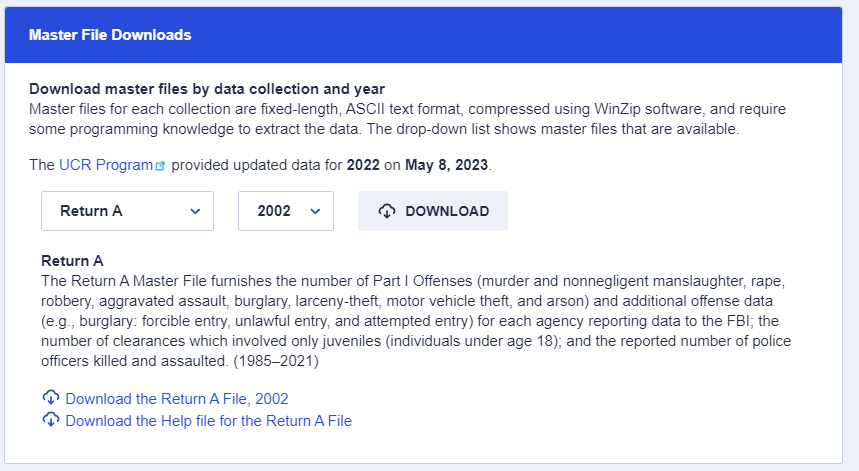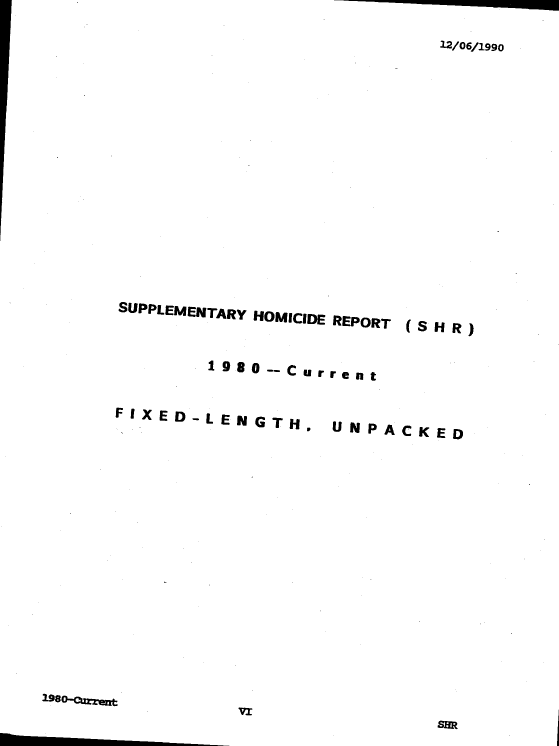The Crime Data Explorer For Dummies
What you need to know to navigate the official crime data waters.
The FBI will release crime data for 2022 in a few weeks which will inevitably lead to panicky requests being received sent to yours truly about how to access the data on the FBI’s Crime Data Explorer. I’m putting together the below guide to hopefully quell some of those requests.
There are four main links to data on the CDE: Crime Data Explorer, Law Enforcement Explorer, Data Discovery Tool, and Documents & Downloads. The section I find to be most useful is the Downloads page because it has all the data you used to find in the old Crime in the US reports (and more!). I find the crime data explorer page and law enforcement explorer page to be not particularly useful. I usually want the raw figures in an easily accessible package and the “Explorer” pages don’t provide that, so they usually get ignored by me.
The downloads page has the good stuff, if you know where to look. Let’s say you want to know how many more murders there were in big cities (1 million+ people) in 2019 than in 2018. Under the old system you would open go find table 12 — Crime Trends, By Population Group, 2018-2019 — which has a handy dedicated URL here and see that murder rose 1 percent in those cities over that span.
Easy!
It is a tad more complicated under the CDE. If you want find the same table for 2019-2020 you’ll need to scroll down to the Crime in the United States Annual Reports on the Downloads page. From there you’ll select the year 2020 and the Offenses Known to Law Enforcement collection, and smash that download button. From there you just have to download the file, open the zip, select the Tables 12-15 Trends folder, open up the Table 12 file, and there you have it! I can't link directly to the table because none of the downloads have dedicated links.
The one major advantage that the CDE has over the old website is the inclusion of the master files. This is the raw data that allows you to see how many crimes every agency reported every month going back to 1985 — a form known as the Return A. You can also download the Supplementary Homicide Report which provides information on every homicide reported to the FBI.
The master files has NIBRS raw data — very intimidating! — arrest data, law enforcement employees data, pretty much anything you might want (though only back to 1985 for some reason). Publishing this data is massively useful as previously you had to request it from the FBI and they would eventually send you a CD with the information you wanted. The negative is that data is all stored in ASCII format, so to use it you have to download the data and then delimit it using a scanned PDF from the 1980s as a guide.
Moving along, the FBI did add a Data Discovery Tool that allows users to pick a crime and get crime data for an agency from 1986 through 2021. Of course there is no way to tell when data reporting is incomplete (like the below screenshot of Philadelphia murders where 2020’s count only included a few months), and from an ease and usefulness perspective it’s still a step below Jacob Kaplan’s excellent website. But it is a step up to have this information reasonably easily accessible.
Under the Crime Data Explorer is your home to all things NIBRS and is where the Quarterly Crime Data is hosted as well. The NIBRS Estimates page provides information on the most recent NIBRS release, including information on how estimates were made.
I can’t overstate how useful the Quarterly data was in 2020. It provided the first evidence that murder was surging in 2020. The quarterly data for the second quarter was published in September 2020 and showed a 15 percent year-on-year increase while the data published in December showed a greater than 20 percent increase through the third quarter.
What’s more, the quarterly table showed how widespread the increase was. Murder was up 18 or more percent in cities over every size suggesting this was not just a big city phenomenon. Having this information 9 months before the Uniform Crime Report was published was incredible.
Sadly, it was not meant to last. The switch to NIBRS has led to too few agencies reporting data to the FBI, so quarterly national estimates have not been made since the fourth quarter of 2020. What’s left is an unaudited and frequently inaccurate table of data from cities over 100,000 which is largely useless IMHO.
Finally, there are law enforcement collections and hate crime data both of which contain incomplete reporting which severely limits their usefulness.
So there is your guide to the CDE which hopefully will be helpful when the 2022 data comes out shortly. The good news is that the FBI is working to address the site’s shortcomings as evidenced by the recent addition of the data discovery tool. The Crime in the US report was largely unchanged for decades which does not mean it couldn't be improved. The current iteration is lacking though efforts to improve the product are ongoing.







Be aware that the Rec-A files are incomplete. They are only the records that were reported. Many agencies don't report.
I first noticed this when building an Rec-A import tool and notice Alabama had reported near no homicides in a test load. Sure enough, they are annually incomplete.
The FBI "imputes" missing data, as does NACJD when they rework FBI data into more usable formats.
www.GunFacts.info
I wouldn't believe anything the FBI has to say. The top four layers of management needs to be thrown out with the trash. They are as crooked as Joe Biden.